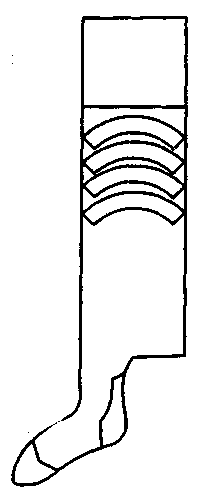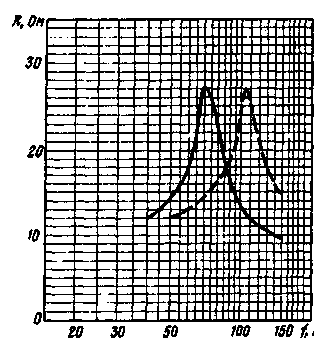
|
|
ENCYCLOPEDIA OF RADIO ELECTRONICS AND ELECTRICAL ENGINEERING Reducing the resonant frequency of the heads. Encyclopedia of radio electronics and electrical engineering
Encyclopedia of radio electronics and electrical engineering / Speakers The lower limit of the frequency range reproduced by the loudspeaker is determined by the main resonant frequency of the head. Unfortunately, there are very few heads on sale that have a fundamental resonant frequency below 60-80 Hz. Therefore, to expand the operating frequency range of acoustic systems, the possibility of reducing the main resonant frequency of the heads used in them seems to be very relevant. As is known, the movable system of the head (diffuser with voice coil) in the region of the main resonance is a simple oscillatory system consisting of the mass and flexibility of the suspension. The resonant frequency of such a system is determined by the formula:
where m is the mass of the diffuser, the voice coil and the attached mass of air, g; C - suspension flexibility, cm / dyne. Thus, in order to reduce the main resonant frequency of the head, it is necessary to increase either the mass of the cone and voice coil, or the flexibility of their suspension, or both. The easiest way is to increase the mass of the diffuser by attaching additional weight to it. However, it is unprofitable to increase the mass of the moving head system, since this will reduce not only the resonant frequency, but also the sound pressure generated by the head. The fact is that the force F created by the current I in the voice coil of the dynamic head is equal to F=B*l*I, where B is the magnetic induction in the gap; l is the length of the voice coil conductor. On the other hand, according to the laws of mechanics, this force is F=m*a, where m is the mass of the moving system; a - oscillatory acceleration. Since the force applied to the voice coil depends for a given head only on the magnitude of the current, then by increasing the mass, we will reduce the oscillatory acceleration of the coil and diffuser by the same amount; and since the sound pressure generated by the head in this frequency region is proportional to the acceleration of the cone, a decrease in acceleration is equivalent to a decrease in sound pressure. If we tried to halve the main resonant frequency of the head, this would require a fourfold increase in the mass of the moving system, and the sound pressure generated by the head would decrease by the same amount at a constant current in the coil. In addition, an increase in mass would increase the quality factor of the moving system and increase the resonant peak, and with it the unevenness of the frequency response, which, in turn, would worsen the transient response of the loudspeaker. Therefore, to reduce the resonant frequency of the head, it is more expedient to increase the flexibility of the diffuser suspension and the centering disk, that is, to reduce the rigidity of the movable system. This is done in the following way. First of all, the diffuser collar is peeled off or cut off with a sharp scalpel or blade (along the ring of the diffuser holder). Then the flexible leads of the voice coil are unsoldered, the ring of the centering disk and the getinaks "spider" (if any) are unscrewed, or the centering disk is peeled off from the diffuser holder. The flexibility of the centering disk with corrugations is increased by cutting three or four cone-shaped holes evenly along the circumference (see Fig. 1). The total area of these holes should be 0,4-0,5 of the area of the corrugations of the centering disc. To protect the magnetic gap from dust, gauze is glued onto the cutouts or the entire disk with ordinary rubber glue or BF-6 glue. If the voice coil is centered with a getinax (textolite) "spider", then the flexibility is increased by reducing the width of its arms (by filing them with a file or carefully biting them with wire cutters). After that, a part of the edge corrugation is cut off at the diffuser so that there is a gap of about 200 mm between the diffuser edge and the diffuser holder ring. If at the same time a corrugation remains on the edge of the diffuser, then it is straightened over a length of about 10 mm and a suspension is glued to it in the form of arches made of vinyl or soft textile vinyl. To increase flexibility, if possible, remove their textile or knitted backing. Very flexible and elastic temples can be made using organosilicon glue - sealant "elastosil" from thin nylon stockings. The top of the stocking is cut lengthwise and markings are made on the resulting canvas 24-28 cm wide (see Fig. 2). When marking, the arms should be located across the stocking (see Fig. 2), since the elasticity of the stocking is greater in the longitudinal direction. Then, putting a piece of smooth polyethylene film on some board or thick cardboard, put a hosiery on it and fix it along the edges with buttons or carnations. After that, with a spatula or the end of a metal ruler, "elastosil" is applied to the knitwear, so that the knitwear threads are not visible. A day later (the polymerization time of "elastosil"), the jersey is turned over and "elastosil" is applied to the other side.
To cut the temples, a cardboard template should be made. It is desirable to hang the diffuser on no more than three or four arches so that each arch occupies, respectively, a third or a quarter of the circumference of the diffuser. On the arms and on the edge of the diffuser, the surfaces with which they should be glued are marked with a pencil, the width of these surfaces should be 7-10 mm. Ready-made bows are smeared alternately with glue and glued to the marked edge of the diffuser with "elastosil" or organosilicon glue KT-30 or MCH-7. Pavinol or textile arches are glued to the surface where the textile was located with BF-2, 88 or AV-4 glue. It is recommended to first check the suitability (compliance) of the adhesive with the material by gluing a piece of material to thick paper. The joints between the arms must also be glued so that there are no gaps. It is best to do this with "elastosil", for pavinol or text-vinyl temples it is recommended to fasten the edges with threads and pour them in several stages with ordinary rubber glue. Having finished the diffuser suspension, it is installed in the diffuser holder so that the voice coil enters the gap. Then the ring of the centering disk is strengthened and the voice coil is pre-aligned (before the suspension is glued). Next, alternately glued to the diffuser holder ring of the diffuser suspension bracket. For bending the temples, when spreading glue on the diffuser holder ring, it is convenient to use crocodile clips with single-pole plugs inserted into them (for gravity). After gluing the suspension, the voice coil is finally centered and the rings of the centering disk or the getinax "spider" are fixed. If the centering disc does not have a metal ring and is peeled off, then first the diffuser suspension is glued, and then the centering disc, while centering the voice coil in the gap. Lastly, the voice coil leads are soldered and support arms made of cardboard, sponge rubber or felt are glued to the diffuser holder. If the diffuser has a crack (rupture), then it is best to seal it with elastosil glue or pour it in several stages with rubber glue. Using the described method, it is possible to reduce the frequency of the main resonance of the head by 1,5-2 times. For an example in fig. 3 shows the frequency characteristics of the impedance of the head 4A-18 before (dotted line) and after rework.
This head was manufactured by the Leningrad film equipment plant "Kinap" in 1954; its alteration consisted in cutting three windows in the centering disk and replacing the edge corrugation with pavinol arches, and the textile backing was not removed. The resonant frequency decreased from 105 Hz to 70 Hz, that is, 1,5 times. It is curious to note that the same reduction in the resonance frequency gives an additional weight of 25 g. Author: M.Ephrussi; Publication: N. Bolshakov, rf.atnn.ru
Artificial leather for touch emulation
15.04.2024 Petgugu Global cat litter
15.04.2024 The attractiveness of caring men
14.04.2024
▪ The quality of raw meat will be determined by x-ray ▪ New series of MINI DORADO LEDs ▪ HGST Ultrastar C10K1800 Hard Drives ▪ The brain is to blame for obesity ▪ New isolated ISO 1050 CAN transceiver
▪ site section Batteries, chargers. Article selection ▪ article But by the way, he will reach certain degrees. Popular expression ▪ article What is Cerebral Palsy? Detailed answer
Home page | Library | Articles | Website map | Site Reviews www.diagram.com.ua |






 Arabic
Arabic Bengali
Bengali Chinese
Chinese English
English French
French German
German Hebrew
Hebrew Hindi
Hindi Italian
Italian Japanese
Japanese Korean
Korean Malay
Malay Polish
Polish Portuguese
Portuguese Spanish
Spanish Turkish
Turkish Ukrainian
Ukrainian Vietnamese
Vietnamese




 Leave your comment on this article:
Leave your comment on this article: